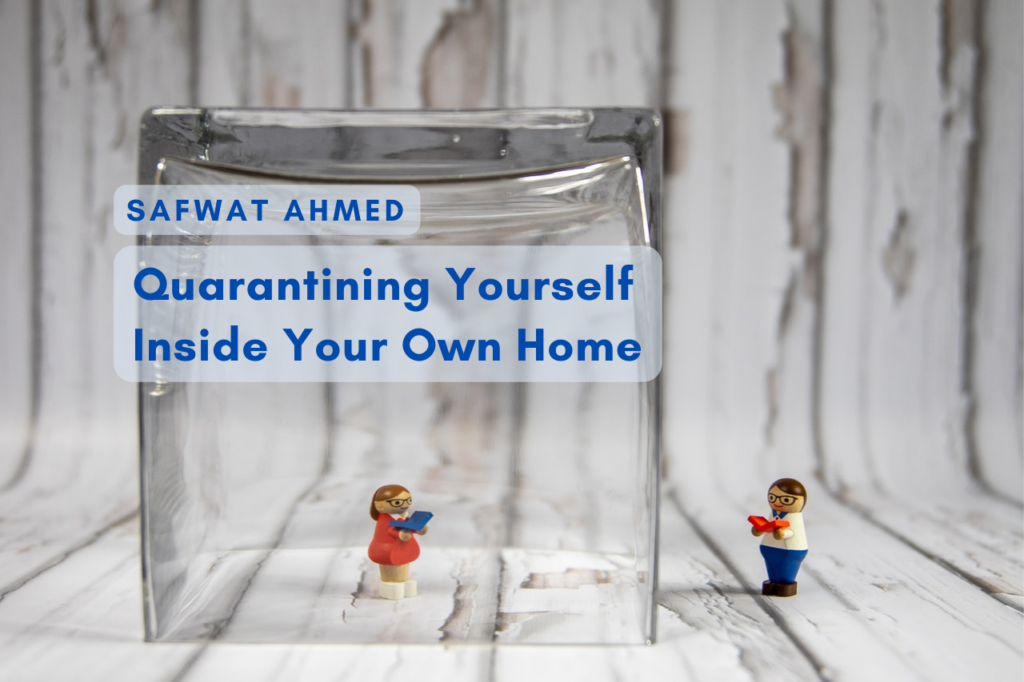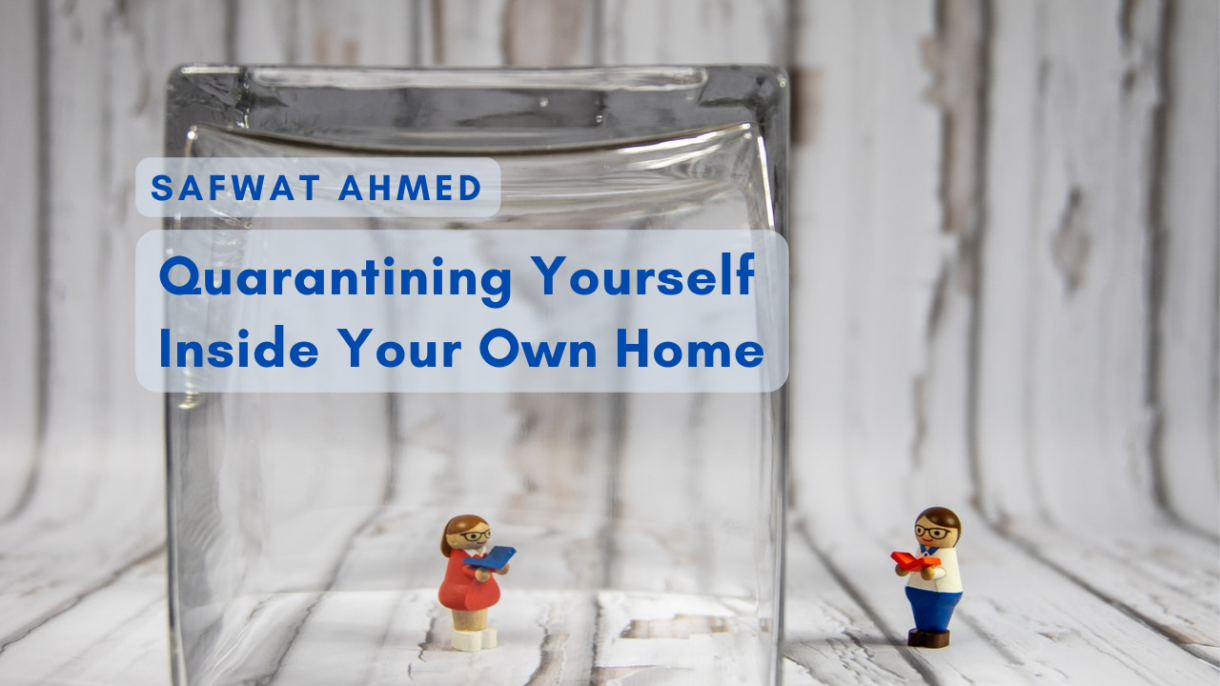
Not too long ago before everyone went into work from home mode, I was worried that my exposure to various people in tightly packed spaces at work would come back with me and harm my family. I met up with people who had carelessly met up with recent returnees from abroad.
I had two things I needed to do. Protect my family from what I’m potentially exposed to, and stop physically going to work where I can expose myself to the virus and potentially become a carrier and harm my other colleagues.
Since what I do at home was completely up to me, I was able to start it right away. And that’s what this guide is about.
Hence I decided to quarantine myself within my own home. This article can serve as a starting point for setting up your own quarantine environment if you have a risk of exposure or are feeling slightly unwell and don’t want to transmit whatever you have to your family.
NOTE: I AM NOT A DOCTOR OR AN EXPERT ON ANY MEDICAL RELATED FIELD.
Do You Own Research Before Implementing These. Check World Health Organization’s Website For Authentic Information.
What we are about to do
The objective is to prevent the transmission of COVID-19 from you to others you share the house with. Thus all forms of exchanges have to be thought off and minimized if not completely eradicated.
Some Possible Points of Transmission:
- During Meals Together
- Having Face to Face Conversations
- Using a Common Washrooms
- Having Physical Contact
These things, without the exception of “Using a Common Washroom” where you don’t have any choice, have to stop immediately.
WE ARE GOING TO GO QUARANTINE MODE, WITHIN THE RESIDENCE.
Setting up the quarantine
At least 14 days’ worth of quarantine preparation has to be taken with an advisable buffer of perhaps another 7 days in case you do start showing symptoms later on but aren’t in need of hospitalization.
Preparing your room
There’s never been a better time to clean up your room and clear our things you don’t need. Clearing things our or bundling them up and storing them in one place is important as it becomes easier to clean up going forward, and you have more space to keep the stuff I’ll suggest now.
These are the stuff you should ideally have in your room if you don’t already have them
- Whatever medicines you need. 21 days worth (don’t take more than that, others need medicines too)
- A small table – this will be your workstation and dining table
- A moderately big trashcan (with trashbags worth 14-21 days of trash)
- Hexisol / Hand sanitizer – One for inside your room
- A thermometer – You should monitor your fever at least twice a day once you start developing symptoms
- Enough water bottles to store 4-5 liters of water
- Glass and Mug
- An electric kettle – Not a must, but a really good nice to have
- A couple of good quality masks
And right outside your door, you need the following:
- Another small table – this can be much smaller, just able to keep 3-4 plates at the same time.
- Hexisol / Hand sanitizer – one to be kept in this smaller table outside the room
Preparing the people you live with
Now it’s time for the people you share the house with. They also have a part in it. Ideally, you’d never come out of your room and, or have face to face close interactions with them.
But if that is not possible, one case might be you have to use a common washroom; then they need to be aware to maintain enough distance from you. Particularly if you have kids or pets in the house they need to be kept a close eye on.
They will need the following:
- Gloves – When moving your trash, used plates
- Masks – If they have to come to your room or close to you.
Some Additional Preparation
Since the objective is undoubted to limit exposure. It helps to minimize the reasons for which you need to go out of the room. Setting up a food stash in your room could help you do just that.
Consider having the following:
- 3-4 Packs of Cereal – For when you get hungry
- 5 Kg Milk Powder – for Cereal, tea, coffee or just milk itself
- 800 gms of Cashew (Wasabi Flavor) – you want something that gives you calories but not something you feel like eating a lot of
- Ferrero Rocher / Snickers / Kitkat – For when you feel low, you will
- Coffee / Teabags – based on your consumption. Keep tea bags anyway for the possible cold you might get. You can switch up between tea and hot water.
- Sugar – Why not?
Living through it
This is not going to be easy in any way. We are social beings by nature and confined to a room in a confined house. If you’re not already used to it, it’s not going to be easy. This is how the following aspects of your life are going to look like:
Work
That Small table is going to be a big part of your life. Surely you could’ve just worked from bed but working from a table is better for your health and productivity.
Food
Ideally, your meals will be prepared by someone else in the house and kept on a plate outside your room in that smaller table I mentioned earlier. You will take the food from there, after whoever kept it has moved back to a safer distance and once you’re done with the food.
Once done, do not put it outside on the table immediately. I actually recommend disposable plates. At the time of writing the article, I wasn’t able to learn how long the virus can survive without outside the host. Some sources say 72 hours but I couldn’t verify the authenticity of those claims.
If disposable plates are not an option, that’s where you delay putting the plates outside your room and whoever collects it wears gloves while doing so.
Having your food supply in the room is also good as it minimizes your interactions and exchanges with the rest of the residents. And you can satisfy your cravings without bothering anyone else.
Having said that, consider rationing your food. If the situation worsens, you can last longer with your stock just by rationing. And since you’re not leaving your room, you’re not burning off enough calories. So rationing is the right way to go if you don’t want to gain weight.
Trash
You should put the trash outside your room sealed in the trash bags and they should be collected by someone wearing gloves.
Mental Health & Wellbeing
Don’t just wake up and start working or watching TV. You’ll get frustrated that way. Have a morning routine. If your room has a balcony or window, go embrace the sunlight. It can be very uplifting.
Take breaks from work. If you don’t have to work because of the emergency (give me your email address, I’m sending you my CV). Do things that are productive anyway.
Have video calls with your family, close friends, and colleagues. This will partially take the edge off.
And exercise regularly. Since you won’t be leaving the room, you will start to feel fatigued. Pushups, Squats can help you take your mind off things.
Physical Health
Take care of your health. If you already have some preexisting conditions and need regular medicine, then take those in a timely manner. Set alarms for yourself if you have to.
If you have asthma, keep your inhaler close by. Take a daily temperature reading of yourself and keep an eye out on credible news sources. Regarding what you should do in what scenario, when should you go to the hospital and when it’s okay to stay home.
Mentioning exercise again, but for your physical health. You don’t want to lose your muscle mass over the quarantine period. Do some freehand exercises to keep yourself healthy.
Going out of the room
I already mentioned, going out of the room is a big NO. But if you don’t have a choice, disinfect your hands wear gloves and get out. Make sure you maintain enough distance from others.
If you’re using a shared washroom, then ensure that you clean it up thoroughly after every use.
Remarks
By now most of you are already staying indoors and have limited risk of exposure now. Yet I am publishing this article now as I have been already following what I have mentioned here and it’s certainly feasible.
This article can be useful for the following scenarios:
- If you are the person in charge of procuring food and other supplies for your family in this situation, you should keep yourself isolated.
- If you start developing symptoms now; you can start isolating yourself from the rest of your flatmates / family members.
- Once the work from home privileges are lifted and you start going out again, you can take some of these cautionary measures
- As winter approaches, given the possibility of Covid-19 making a seasonal comeback, you can take some of the measures.
As mentioned earlier, I am not an expert on this matter. I’m someone who likes to take necessary measures. Please don’t take it as a full-proof guide, rather just a starting guideline.
I wish you and your loved ones all the best. Flatten the curve, say safe!


